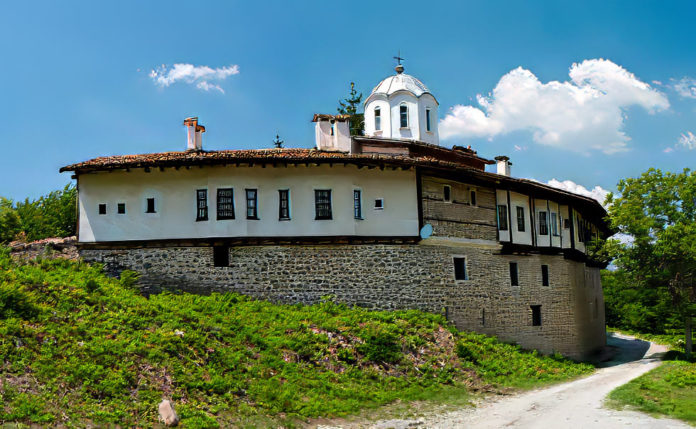Where Forest and Faith Intertwine
Not far from the former royal capital of Veliko Tarnovo, the forest road curves downward into a green fold of the Elena Balkan. There, embraced by oak trees and serenaded by the Kapinovski River, rests one of Bulgaria’s most soul-soothing sanctuaries: Kapinovski Monastery “Saint Nicholas the Wonderworker”.
Here, it’s easy to forget what century you’re in. The monastery’s stone walls, faded frescoes, and terracotta rooftops seem to float on a cushion of stillness – the river hums in the background. Swallows dive through the cloisters. And everything—the light, the forest, the faith – feels tenderly untouched.
A Monastery Rooted in Time
The origins of Kapinovski Monastery stretch back to the 13th century, during the reign of Tsar Ivan Asen II, when Bulgaria was a powerful Orthodox kingdom and Tarnovo was a cultural beacon. Legend says the monastery was founded by a boyar (nobleman) seeking refuge and divine protection during political turmoil.
Though often destroyed and rebuilt, the monastery’s enduring spirit has never faded. The current structure dates mainly to the 19th century, rebuilt in 1835 after being burned during Ottoman times. Local craftsmen, known for their skill and artistry, restored the stone church and residential wings in the Bulgarian National Revival style—marked by thick walls, wooden porches, and humble grace.
The complex includes a main church (katholikon) dedicated to St. Nicholas the Wonderworker, monks’ quarters, a bell tower, and a peaceful courtyard shaded by walnut trees. A small cemetery nearby holds the remains of monks and benefactors, their stones worn smooth by rain and prayer.
A Canvas of Faith: The Church and Its Frescoes
Walk through the heavy wooden doors of the monastery church, and you enter a world painted with devotion. The interior is adorned with frescoes from the 1850s, created by local iconographers trained in the Mount Athos tradition. The colors—muted golds, earthy reds, and deep blues—evoke both heaven and soil.
One standout detail is the iconostasis, a richly carved wooden screen separating the nave from the altar. It holds icons of Christ Pantocrator, the Virgin Mary, and Bulgarian saints, including St. Ivan Rilski, protector of Bulgarian monasticism.
The atmosphere inside is hushed and holy. Even the sunlight that filters through the narrow windows seems to tread gently, as if it too is in prayer.
The Monastery Today: Tranquility for All
Unlike more touristy monasteries, Kapinovski is still a functioning monastic community, though it welcomes pilgrims, hikers, and travelers with open arms. The monks live modestly, tending to the grounds, offering blessings, and maintaining the rhythms of Orthodox life.
What you can do here:
- Light a candle and reflect in the church’s candle corner
- Walk the grounds under walnut trees and along the river
- Talk with a monk (if you’re lucky)—they’re often quiet, but kind
- Stay overnight in one of the monastery’s simple guest rooms
- Swim or picnic at the Kapinovski waterfall, just minutes away
Nearby Natural Beauty: Waterfalls, Walks, and a Touch of Wild
Just a short walk from the monastery lies Kapinovski Waterfall (Kapinovski Vodopad), a gentle 10-meter cascade that tumbles into a clear, cold pool. In summer, it’s a favorite spot for a refreshing dip or a riverside picnic. Another waterfall – the Hrostovski Waterfall is also nearby.
The area is part of the Elena Balkan, a region known for its soft, forested slopes, wild herbs, and hidden trails. You can hike or drive to the Yovkovtsi Reservoir, or continue onward to the Elena Renaissance Trail, where timeworn villages, watermills, and Orthodox chapels dot the hills.
How to Get There
Kapinovski Monastery feels remote, but it’s surprisingly accessible – the monastery on the map.
By Car
- From Veliko Tarnovo: ~18 km south (~25 minutes), via the village of Velchevo
- From Sofia: ~240 km (~3.5 hours), via Hemus Highway and Veliko Tarnovo
- From Plovdiv: ~190 km (~3 hours), via Stara Zagora and Gurkovo Pass
Tip: The last few kilometers are on a narrow rural road but are paved and scenic. Parking is available at the monastery and the nearby eco-complex.
By Public Transport
No direct buses to the monastery. It is possible to take a bus to Velchevo or Elena, then arrange a taxi or transfer (approx. 20–30 BGN). Alternatively, rent a car in Veliko Tarnovo for the day.
Where to Stay and Eat
You can stay overnight at the monastery or at the nearby Kapinovski Monastery Eco-Complex, a rustic hotel with a restaurant and pool. Ideal for families, couples, or solo travelers seeking comfort near nature.
What to eat nearby:
- Elenski but (Elena dry-cured ham) – a regional delicacy
- Fresh trout from the river
- Homemade lyutenitsa, white cheese, and mountain honey
Ask for herbal tea, many are brewed from wild herbs gathered nearby: thyme, mint, elderflower.



